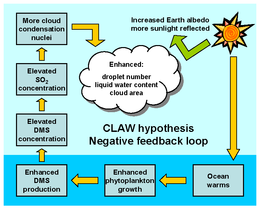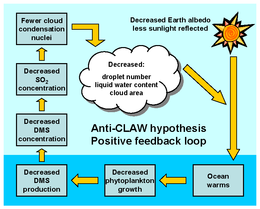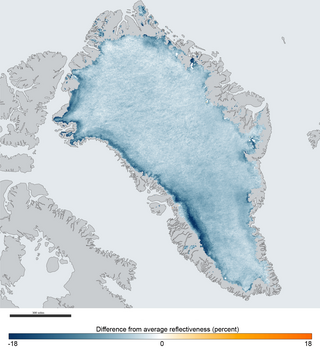
Albedo is the fraction of sunlight that is diffusely reflected by a body. It is measured on a scale from 0 to 1.
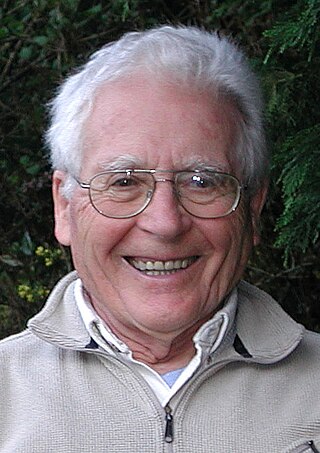
James Ephraim Lovelock was an English independent scientist, environmentalist and futurist. He is best known for proposing the Gaia hypothesis, which postulates that the Earth functions as a self-regulating system.

Cloud albedo is a measure of the albedo or reflectivity of a cloud. Clouds regulate the amount of solar radiation absorbed by a planet and its solar surface irradiance. Generally, increased cloud cover correlates to a higher albedo and a lower absorption of solar energy. Cloud albedo strongly influences the Earth's energy budget, accounting for approximately half of Earth's albedo. Cloud albedo depends on the total mass of water, the size and shape of the droplets or particles and their distribution in space. Thick clouds reflect a large amount of incoming solar radiation, translating to a high albedo. Thin clouds tend to transmit more solar radiation and, therefore, have a low albedo. Changes in cloud albedo caused by variations in cloud properties have a significant effect on global climate.

Phytoplankton are the autotrophic (self-feeding) components of the plankton community and a key part of ocean and freshwater ecosystems. The name comes from the Greek words φυτόν, meaning 'plant', and, meaning 'wanderer' or 'drifter'.

The Gaia hypothesis, also known as the Gaia theory, Gaia paradigm, or the Gaia principle, proposes that living organisms interact with their inorganic surroundings on Earth to form a synergistic and self-regulating, complex system that helps to maintain and perpetuate the conditions for life on the planet.
Nephology is the study of clouds and cloud formation. British meteorologist Luke Howard was a major researcher within this field, establishing a cloud classification system. While this branch of meteorology still exists today, the term nephology, or nephologist is rarely used. The term came into use at the end of the nineteenth century, and fell out of common use by the middle of the twentieth. Recently, interest in nephology has surged as many meteorologists have begun to focus on the relationship between clouds and global warming which is a major source of uncertainty regarding "...estimates and interpretations of the Earth’s changing energy budget."
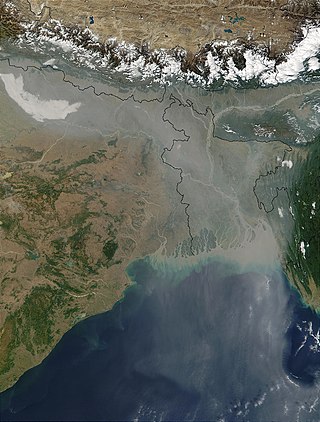
Cloud condensation nuclei (CCNs), also known as cloud seeds, are small particles typically 0.2 µm, or one hundredth the size of a cloud droplet. CCNs are a unique subset of aerosols in the atmosphere on which water vapour condenses. This can affect the radiative properties of clouds and the overall atmosphere. Water requires a non-gaseous surface to make the transition from a vapour to a liquid; this process is called condensation.

Emiliania huxleyi is a species of coccolithophore found in almost all ocean ecosystems from the equator to sub-polar regions, and from nutrient rich upwelling zones to nutrient poor oligotrophic waters. It is one of thousands of different photosynthetic plankton that freely drift in the photic zone of the ocean, forming the basis of virtually all marine food webs. It is studied for the extensive blooms it forms in nutrient-depleted waters after the reformation of the summer thermocline. Like other coccolithophores, E. huxleyi is a single-celled phytoplankton covered with uniquely ornamented calcite disks called coccoliths. Individual coccoliths are abundant in marine sediments although complete coccospheres are more unusual. In the case of E. huxleyi, not only the shell, but also the soft part of the organism may be recorded in sediments. It produces a group of chemical compounds that are very resistant to decomposition. These chemical compounds, known as alkenones, can be found in marine sediments long after other soft parts of the organisms have decomposed. Alkenones are most commonly used by earth scientists as a means to estimate past sea surface temperatures.

Dimethylsulfoniopropionate (DMSP), is an organosulfur compound with the formula (CH3)2S+CH2CH2COO−. This zwitterionic metabolite can be found in marine phytoplankton, seaweeds, and some species of terrestrial and aquatic vascular plants. It functions as an osmolyte as well as several other physiological and environmental roles have also been identified. DMSP was first identified in the marine red alga Polysiphonia fastigiata.
Ice algae are any of the various types of algal communities found in annual and multi-year sea, and terrestrial lake ice or glacier ice.

Dimethyl sulfide (DMS) or methylthiomethane is an organosulfur compound with the formula (CH3)2S. The simplest thioether, it is a flammable liquid that boils at 37 °C (99 °F) and has a characteristic disagreeable odor. It is a component of the smell produced from cooking of certain vegetables, notably maize, cabbage, beetroot, and seafoods. It is also an indication of bacterial contamination in malt production and brewing. It is a breakdown product of dimethylsulfoniopropionate (DMSP), and is also produced by the bacterial metabolism of methanethiol.

Sea spray are aerosol particles formed from the ocean, mostly by ejection into Earth's atmosphere by bursting bubbles at the air-sea interface. Sea spray contains both organic matter and inorganic salts that form sea salt aerosol (SSA). SSA has the ability to form cloud condensation nuclei (CCN) and remove anthropogenic aerosol pollutants from the atmosphere. Coarse sea spray has also been found to inhibit the development of lightning in storm clouds.

The Revenge of Gaia: Why the Earth is Fighting Back – and How We Can Still Save Humanity (2006) is a book by James Lovelock. Some editions of the book have a different, less optimistic subtitle: Earth's Climate Crisis and the Fate of Humanity.

Marine cloud brightening also known as marine cloud seeding and marine cloud engineering is a proposed solar radiation management climate engineering technique that would make clouds brighter, reflecting a small fraction of incoming sunlight back into space in order to offset anthropogenic global warming. Along with stratospheric aerosol injection, it is one of the two solar radiation management methods that may most feasibly have a substantial climate impact. The intention is that increasing the Earth's albedo, in combination with greenhouse gas emissions reduction, carbon dioxide removal, and adaptation, would reduce climate change and its risks to people and the environment. If implemented, the cooling effect is expected to be felt rapidly and to be reversible on fairly short time scales. However, technical barriers remain to large-scale marine cloud brightening. There are also risks with such modification of complex climate systems.
Sea salt aerosol, which originally comes from sea spray, is one of the most widely distributed natural aerosols. Sea salt aerosols are characterized as non-light-absorbing, highly hygroscopic, and having coarse particle size. Some sea salt dominated aerosols could have a single scattering albedo as large as ~0.97. Due to the hygroscopy, a sea salt particle can serve as a very efficient cloud condensation nuclei (CCN), altering cloud reflectivity, lifetime, and precipitation process. According to the IPCC report, the total sea salt flux from ocean to atmosphere is ~3300 teragrams (Tg) per year.
Meinrat O. Andreae, born in 1949 in Augsburg, is a German biogeochemist. Since 1987, he has worked as Director and Scientific Member at the Max Planck Institute for Chemistry (MPIC) in Mainz.

The North Atlantic Aerosols and Marine Ecosystems Study (NAAMES) was a five-year scientific research program that investigated aspects of phytoplankton dynamics in ocean ecosystems, and how such dynamics influence atmospheric aerosols, clouds, and climate. The study focused on the sub-arctic region of the North Atlantic Ocean, which is the site of one of Earth's largest recurring phytoplankton blooms. The long history of research in this location, as well as relative ease of accessibility, made the North Atlantic an ideal location to test prevailing scientific hypotheses in an effort to better understand the role of phytoplankton aerosol emissions on Earth's energy budget.
Patricia K. Quinn is a atmospheric chemist working at the National Oceanic and Atmospheric Agency's Pacific Marine Environmental Lab. She is known for her work on the impact of atmospheric aerosol particles on air quality and climate.
Glenn Edmond Shaw is an American scientist specializing in atmospheric physics, especially relating to global climate change and long-range transport of aerosol material. He is Emeritus Professor of Physics and Atmospheric Science at the University of Alaska Fairbanks and a member of the scientific staff of the Geophysical Institute. He conducted research on global atmospheric transport of aerosols and feedback of biogenic aerosols on global climate. He and Kenneth Rahn did research on the sources and climatic effect of Arctic haze. He did pioneering work on the scientific concept of climate homeostasis through the sulfur cycle and atmospheric aerosol.
Patricia Ana Matrai is a marine scientist known for her work on the cycling of sulfur. She is a senior research scientist at Bigelow Laboratory for Ocean Sciences.

